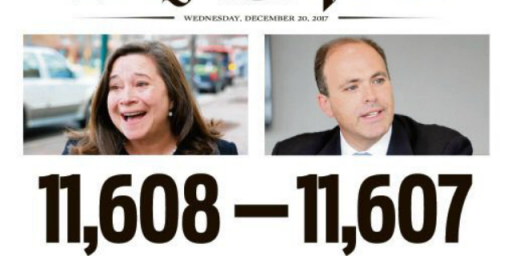Disputed Virginia Election Heads To Court
The battle for control of the Virginia House of Delegates remains up in the air as both sides continue to dispute the outcome in one district.
The battle for control of the Virginia House of Delegates remains up in the air thanks to one unresolved election in Virginia’s Tidewater region, and it appears that the outcome will remain unresolved for at least a few more weeks. After Election Day, when Democrats swept all three statewide offices and made significant gains against the seemingly insurmountable Republican majority in the lower house of the state legislature, it first appeared that the race for the 49th District seat held by Republican David Yancey had gone to the GOP by a razor-thin ten vote margin, an outcome that would maintain Republican control by a single seat. After a recount, though, voting officials announced that Yancey’s Democratic challenger Shelly Simmonds had won the seat by a single vote. A day later, though, the judicial panel overseeing the recount ruled that a disputed ballot that appeared to include a mark for both Yancey and Simmonds would be counted for Yancey, thus making the result a tie. Pursuant to Virginia law, in the unlikely event that an election for any race ends in a tie, the outcome is to be determined by the drawing of names out of a lot, a process that was supposed to take place today. That event, however, has been put on hold thanks tolegal papers filed by lawyers for Simmonds and the state Democratic Party contesting the result in light of the decision to count that one disputed ballot:
A race that would tip control of Virginia’s House of Delegates, whose constant and nearly comic pendulums between candidates has attracted national attention, took one more twist on Tuesday when a drawing to break a tie was unexpectedly postponed.
The Virginia State Board of Elections announced it would delay a drawing of lots after receiving a letter from lawyers for the Democratic candidate, Shelly Simonds, that she was legally fighting the ruling of a recount court last week.
The election board’s one-line announcement, on Twitter, came just hours after an announcement that there would be a live video stream of the drawing, which was to be held adjacent to the State Capitol, in response to the huge interest in the race beyond Virginia.
Republicans, who have held majorities for 17 years in the State House, cling to a 51-49 edge after a Democratic wave in elections last month. A Simonds victory would force a bipartisan power sharing and give Ralph Northam, the Democratic governor-elect, an improved shot at enacting liberal priorities.
A drawing in the event of a tie — picking out of a bowl one of two film canisters with the candidates’ names inside — is decreed by state law. That was where the race in House District 94 was headed until Tuesday, in a contest that has had more pirouettes than a prima ballerina since voters went to the polls seven weeks ago, choosing the Republican incumbent, David Yancey, by 10 votes.
James Alcorn, the chairman of the election board, said that although the scheduled drawing was in full compliance with the law, “neutral election administrators should not be choosing election winners — or influencing the next speaker of the House.”
Then, in a reversal the next day, a three-judge court reviewing the recount chose to include a questionable ballot for Mr. Yancey. The election was deadlocked: 11,608 votes each.
Ms. Simonds said on Tuesday she would file motions with the recount court in Newport News challenging its decision about the questionable ballot, which had been brought before the court by lawyers for Mr. Yancey.
Ms. Simonds’s lawyers said the ballot had been thrown out in the recount for good cause and should never have been reconsidered. It shows that a voter filled in bubbles for both Mr. Yancey and Ms. Simonds, then drew a faint line through the Simonds vote. Ms. Simonds’s lawyers argue that the court is opening a Pandora’s box by letting ballots that were uncontested during the recount to be introduced piecemeal during the customary judicial certification of the recount.
“I stand by the results of the recount,” Ms. Simonds told reporters on a conference call. “I believe it was a fair process guided by rules.” Mr. Yancey had not liked the recount, she said, so he “made an end run” in court.
The three-judge panel handling this recount will no doubt be expeditious in ruling on the motions given the fact that the new state legislature is due to be sworn in very shortly, but the possibility remains that we could go into the new year with control of the lower chamber up in the air thanks to this one unresolved seat. At least momentarily, Republicans maintain a majority based on the fact that the seat is unresolved, but that would change immediately if Simmonds ends up being declared the winner and brings a tie to the legislature. That would result in the need for a power-sharing agreement of some kind between Republicans and Democrats not dissimilar from the one that has been in effect several times in the State Senate, which has drifted back and forth from Democratic to Republican control several times over the past decade. That alone could prove significant and could end up having a significant impact on Virginia politics for years to come. It’s also worth noting that the current legal proceedings aren’t necessarily the end of the road. Whatever ruling we get from the panel overseeing the recount would be immediately appealable to the Virginia Supreme Court, and while that court too would likely seek to rule on the matter on an expedited basis it could be some time before the process is complete and a winner declared.
As Jazz Shaw notes a Hot Air, though, no matter who wins, the outcome of this race, and the issue of control of the House of Delegates is going to remain a point of dispute:
[W]ho is actually going to believe in the result? This is something which our electoral system has rarely been able to come to grips with historically. The original idea of direct elections was that any large enough population, when presented with a (usually) binary choice, would break in one direction or the other by a reasonable enough margin to declare that the outcome represented the will of the majority. There were more than 23,000 votes cast in this race. The odds of an exact tie were astronomical, but it apparently happened. Even if the original count had stood, giving Yancey a ten vote margin, why should anyone in the district feel that the majority had prevailed? And now we’re looking at a situation where a court will have to step in and decide whether one smudged, improperly completed ballot will or won’t be counted. The outcome will ride in part on that decision. And if it’s counted, then we’re going to pick a name out of a bowl?
As Jazz notes, these questions will exist regardless of how the race is decided. Even if the original result had withstood the recount and Yancey was declared the victor by ten votes, that would hardly be considered as a decisive victory and the people on the other side of the election would understandably be frustrated at the outcome. The same will be true if the disputed ballot is again thrown out and Simmonds is declared the winner, or if it is kept in and either Simmonds or Yancey declared the winner just because their name was drawn out of a bowl. The ideal outcome in that type of situation, of course, would be to re-do the election, I suppose, but even that would be an imperfect outcome that would leave both sides unsatisfied. In any case, there is no provision in Virginia law for such an election and I don’t believe that any court would have the jurisdiction to order such an election even if it wanted to do so. Additionally, at some point, there needs to be some degree of certainty and finality when it comes to election results and one side or the other declared the winner. As it stands, whoever that is will have to defend it again in 2019 when the entire state legislature, including both the Senate and the House of Delegates, will be up for re-election in what will likely be an aggressively fought battle that could have a significant impact on the redistricting battle that will take place after the 2020 Census.





That ballot should have been tossed and never considered. There are X’s and filled bubbles and both. How are the judges on this panel supposed to be able to divine the intent of a voter who themselves didn’t seem to know who he/she wanted to vote for? They’d do just as well to scramble a goat’s entrails in a bowl.
My immediate impression was that it looked like a vote for the Republican.
@Mikey:
For all I know that could be how an election result like this is resolved in some parts of the world.
@michael reynolds:
That’s certainly a reasonable interpretation, but then so is the conclusion that the ballot is too unclear to make a fair determination and that the vote in the HoD rates should therefore not be counted.
It’s kind of like the hanging chad issue from Florida 2000, there isn’t necessarily a “right” answer since you can’t know what was in the mind of the voter, especially since there’s already a procedure in place for a voter who accidentally mismarks a ballot. All they need to do is tell one of the official election workers and the mis-marked ballot will be immediately destroyed and they’ll be given a new clean one to mark correctly.
@michael reynolds:
I think that the probability is that the voter wanted to vote for the Republican. However, I think that it is impossible to fully discern the voter’s intent from the ballot in question from a legal POV, and therefore it should not be counted.
Having said that, given the closeness of the election, drawing lots may be the fairest outcome.
@michael reynolds: The governor’s race has only a single bubble filled, and that has an x through it as well. Did they start with an X, then realize they had to fill in a bubble, or did they fill in a bubble and then decide against it? I suspect the former, but if I apply the same standard to the HoD race, I have no idea what that means.
The only thing that makes me think this was meant to be a vote for a Republican is that it is a straight Republican ballot, if we think they intended to vote for the Republican for governor. If they had voted for a Republican here and a Democrat there, we would be staring at this race’s entry baffled. I’m not comfortable saying that a straight ballot voter has special rights regarding the interpretation of their ballot.
@Doug Mataconis: The hanging chads were pretty clear — that’s just poor voting technology. If we treat the hanging chads as a mysterious “we can never know” you end up with a freakishly high rate of spoiled ballots on the most popular race (where they would also appear more commonly for the more popular candidate in the precinct — I.e., the spot that has the most paper build up from previous ballots)
Dimpled ballots were unclear, but only because of the rarity.
@Mikey: I was thinking of a round robin double elimination Mancala tournament, to be held in Las Vegas.
I realize that they’ve already looked through them all again, but even if this mildly ambiguous one is for the Republican, were there any others that were even the slightest bit ambiguous out of the 23,000+ ballots? At some point you have to draw a line.
Statistically, of course, there’s no doubt it’s basically equivalent to a tie, whether one person wins by 10 or the other by 1. But somebody has to fill the seat, better luck to the other team next time.
@michael reynolds:
My immediate impression was that it is a spoiled ballot. Virginia law (Va. Code Ann. § 24.2-645) clearly mandates that all the voter in question had to do was ask for a replacement ballot & one would have been provided to him/her, and he/she chose not to do so.
It’s spoiled. It should be rejected as such. The absolute last thing we need is subjective opinions deciding elections. Either you mark your ballot correctly, obtain a replacement if you’re too dumb to manage that the first time around, or it gets discarded.
@HarvardLaw92: I concur that there is no way to count that vote for either candidate.
@Doug Mataconis: For all I know that could be how an election result like this is resolved in some parts of the world.
That’s pretty condescending, don’t you think?